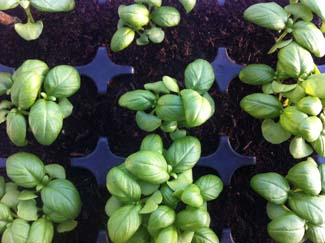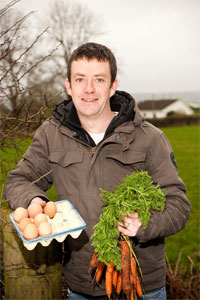Grow it Yourself - June
 I am doing a lot of transplanting at the moment, which is always a fun activity for a GIYer. There’s nothing like the satisfaction of planting seedlings – bare beds transformed in an instant with neat rows of little plants.
I am doing a lot of transplanting at the moment, which is always a fun activity for a GIYer. There’s nothing like the satisfaction of planting seedlings – bare beds transformed in an instant with neat rows of little plants.
I always feel intensely happy after spending some time planting – and now I know that there is actually a scientific reason for this – contact with soil triggers the release of serotonin in our brain according to research. Serotonin is the happy chemical – it is a natural anti-depressant and strengthens the immune system.
On the other hand, there are always a few days of fretting after transplanting– will cold nights set the plants back? Will slugs or rabbits try and munch on them?
Seed sowing is a relatively exact science – if you sow a seed at the right temperature and at the right depth, and you keep the potting compost moist, then it will generally germinate rather reliably. In addition, up to the point that they are transplanted, the seedlings have luxuriated in the 5-star comfort of my potting shed.
They have been nurtured, spoiled, cossetted. I’ve carefully watered them each day, switched on heat underneath them at night and covered them with fleece. The potting shed is a controlled environment – there is no weather in there – no rain or wind. Nor are there any pests to trouble them – leather jackets, slugs, snails, birds or rabbits.
Planting a seedling out in the soil therefore is a watershed moment. It is the moment it leaves a very controlled environment in favour of something far more uncontrolled, unpredictable and messy. And like a parent sending a child off to school for the first time, you just have to have faith and let it go in to the mad, bad world!!
 Things to do this Month
Things to do this Month
To-Do
Watering and weeding duties step up a notch – the tunnel/greenhouse in particular will require a good deal of water from now on. Watch the weather and water outside as required. Continue to earth-up potato plants to prevent the spuds becoming green. Mulch and water tomato plants and continue to remove side shoots that appear in the leaf axils. Stake everything that grows tall – raspberries, peas, beans, tomatoes etc. Net soft fruit against birds – it’s worth the effort.
Sow
Sow courgettes, pumpkins, summer and winter squash, fennel, chicory. Succession sow: beans (French and Runner), kale, pea, spinach, spinach beet, summer broccoli, carrot, swede, leek, lettuce, Brussels sprouts, beetroot, chicory, endive, turnip, kohlrabi, fennel. Plant out leeks, Brussels Sprouts, cabbage, autumn cauliflower, calabrese, sprouting broccoli, celery, celeriac, cucumbers, pumpkin, marrows, runner beans, aubergine.
Harvest
We are now really starting to see some payback from our GIYing - the first broad beans and peas as well as new potatoes, new carrots, soft fruit like gooseberries, cherries and strawberries. Herbs are in full flow. Also harvest kohlrabi, cabbage, cauliflower (month end), spinach, spring onion, shallots, salad leaves, elderflower, rhubarb, salad leaves, onions, carrots, beetroot, garlic, sea-kale.
Recipe of the Month – Broad Bean Hummus
At some point last year I decided I was never growing broad beans again, because I reckoned I actually didn’t like their taste much. Then I discovered this recipe from our old mucker Hugh Fearnley Whittingstall which turns them in to a cracking hummus.
Serves 4.
Ingredients:
• 400g shelled broad beans
• ½-1 garlic clove, crushed with a little salt
• Approx 3 tbsp rapeseed or extra virgin olive oil
• Generous squeeze of lemon juice
• Sea salt and freshly ground black pepper
Put the broad beans in a pan, cover with water and bring to the boil. Lower the heat and simmer for 5-10 minutes (depending on age and size) until tender, then drain. Set aside to cool, then slip the beans out of their skins.
Put the skinned broad beans in a food processor or blender with the garlic, 3 tablespoons of oil, a good squeeze of lemon juice and some salt and pepper. Process to a thick, slightly coarse purée, adding more oil if it seems too thick and dry.
When you're happy with the texture, transfer the purée to a bowl. Taste and adjust the seasoning with more salt, pepper and lemon juice as needed. Delicious with a slice of ham in a pitta bread or bap (or a blaa if you’re a Waterford boy like me).
Tip of the Month – Manually pollinating courgette plants
In cold or very wet summers, you may notice that fruit is not forming well on your courgette plants. This can be because pollination is poor (lack of insects to move the pollen from the male to female plant).
The problem can be fixed by getting all Charles Darwin and pollinating the plants manually. Remove a male flower from the plant and brush the central parts against the centre of a female flower (the pollen from the male plant is rubbed against the stigma of the female plant).
The female flowers are the ones that have a small fruit starting to form behind them. The male flowers don't.
------------------------------------
We are trying to get 100,000 people to take a pledge to grow something they can eat – take the GIY pledge at www.facebook.com/giyireland.
 Michael Kelly is a freelance journalist, author and founder of GIY Ireland.
Michael Kelly is a freelance journalist, author and founder of GIY Ireland.
GIY’s vision is for a healthier, more connected and more sustainable world where people grow their own food. We bring people together in community groups and online to inspire and empower them to grow vegetables. There are over 100 GIY community groups and approximately 12,000 people involved in the movement around Ireland. GIY is a registered charity – CHY 18920.
For more tips, information and support visit www.giyireland.com.
© GIY Ireland 2012 – all rights reserved.





There are currently no comments
Leave a comment
Not a member? Register for your free membership now!
Or leave a comment by logging in with: